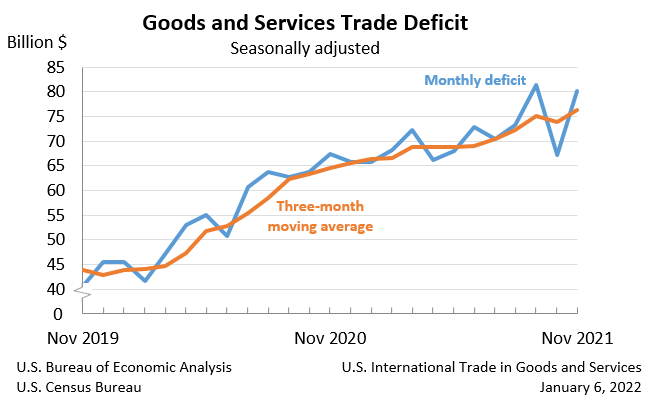Supply chain bottlenecks, a pandemic, tariffs on over $250 billion worth of China goods, have done nothing to stop the U.S. from hitting a trillion-dollar-plus goods trade deficit in 2021.
As of November, the goods trade deficit alone is $984.7 billion on a Census basis, the Bureau of Economic Analysis (BEA) reported on Thursday. The November 2021 trade deficit in goods was $98 billion, the highest of the year due to the holiday season.
If the December goods deficit, out next month, comes in at just $85 billion (which was the lowest monthly trade deficit figure in 2021), then the goods deficit for 2021 will be $1.069 trillion, a record.
U.S. imports in the first eleven months of 2021 were $3.1 trillion. When we add in December, imports could reach $3.5 trillion. To put that into perspective, the entire Mexican economy had a 2020 GDP of $1.7 trillion and the Canadian economy $1.6 trillion. So the U.S. is, in essence, importing the equivalent of the entire Mexican and Canadian economies combined. If just a portion of that demand was made here, it would lead to more jobs, higher wages, a stronger middle class, and a higher tax base for states to fund social services.
“Over 3% of our GDP is going to net imports,” said Jeff Ferry, chief economist for CPA. “That’s a huge loss for the U.S. economy.”
The U.S. goods trade deficit in 2020 was $911 billion and $850.9 billion in 2019.
The BEA data today showed that November’s goods and services trade deficit rose by $13 billion to $82 billion. For the first eleven months of 2021, the goods and services deficit stands at $785.5 billion, already a U.S. and world record, even before December is counted. https://www.bea.gov/sites/default/files/2022-01/trad1121.pdf
A strong dollar has muted most of the trade war tariffs, making it more enticing for American companies to source cheaply overseas.
The November increase in the goods and services deficit reflected an increase in the goods deficit of $15.1 billion to $99 billion and an increase in the services surplus of $2.1 billion to $18.8 billion, the BEA said. Year-to-date, the goods and services deficit increased $174.6 billion, or 28.6%, from the same period in 2020. Exports rose $354.4 billion or 18.2% and imports increased $529.0 billion or 20.7%.

November Trade Gaps
November trade deficits were biggest with the usual countries, with China leading the way at $28.4 billion, seasonally adjusted. Not far behind is the European Union ($19.4 billion), then Mexico ($11 billion), Germany ($6.1 billion) and Canada ($5.4 billion).
Looking at the trade gaps from a non-adjusted Census basis and we see that:
- The trade deficit in goods with China was $32.3 billion, the second-biggest deficit of the year after September when it was around $36.5 billion.
- The U.S. had a $5.9 trillion goods trade deficit with Ireland, the biggest of the year, and larger than the U.S. trade deficit with Japan ($4.1 billion). Ireland is not only an offshore haven for American multinationals but is also a big exporter of pharmaceutical goods to the U.S.
- The goods deficit with Vietnam has broken a record and reached $8.5 billion in November, up from the previous record on the year reached in August ($8.4 billion).
Southeast Asia continues to build out as an outpost for Chinese multinationals and others looking to escape China tariffs.
All told, the Vietnam goods trade deficit for the year is now $82.36 billion, up from $69.7 billion in 2020. No one compares to Vietnam in terms of export growth to the U.S. The closest two in southeast Asia are Malaysia and Thailand. While both countries have seen an increase in exports to the U.S., they are moderate compared to the growth coming out of Vietnam. Much of this is driven by Chinese multinationals, including those in the solar space.
As of November 2021, the U.S. goods deficit with Malaysia was $37.2 billion, up from $31.8 billion in 2020. The goods deficit with Thailand is $31.5 billion, up from $26.3 billion in 2020.
CPA expects these three countries to increase their exports to the United States again this year. The trade gap is mostly due to the fact that these countries are poor, have weak currencies, and are not buying much of anything from the United States.
Closer to home, our goods deficit with Mexico is likely to be smaller this year. As of November, the goods deficit on a Census weighted basis is $98.74 billion. It ended 2020 at $113.7 billion. For that to happen again, the December trade deficit would have to be more than $14 billion, which would smash last year’s monthly record high of $12.7 billion.
“The best way to reduce the trade deficit, stimulate U.S. production, and get a grip on inflation is to take action to incentivize manufacturers to relocate production out of Asia and into the U.S.,” said Ferry.













